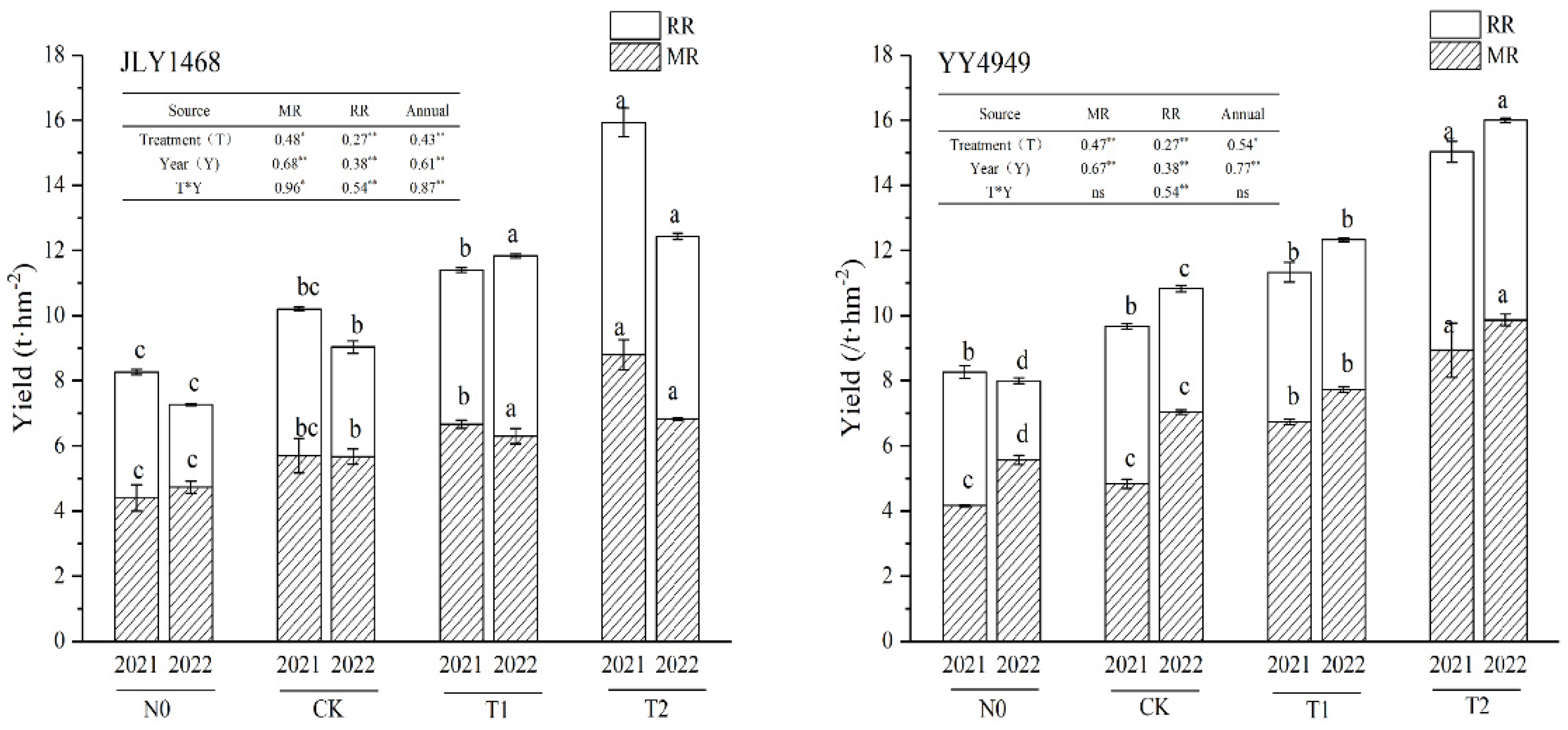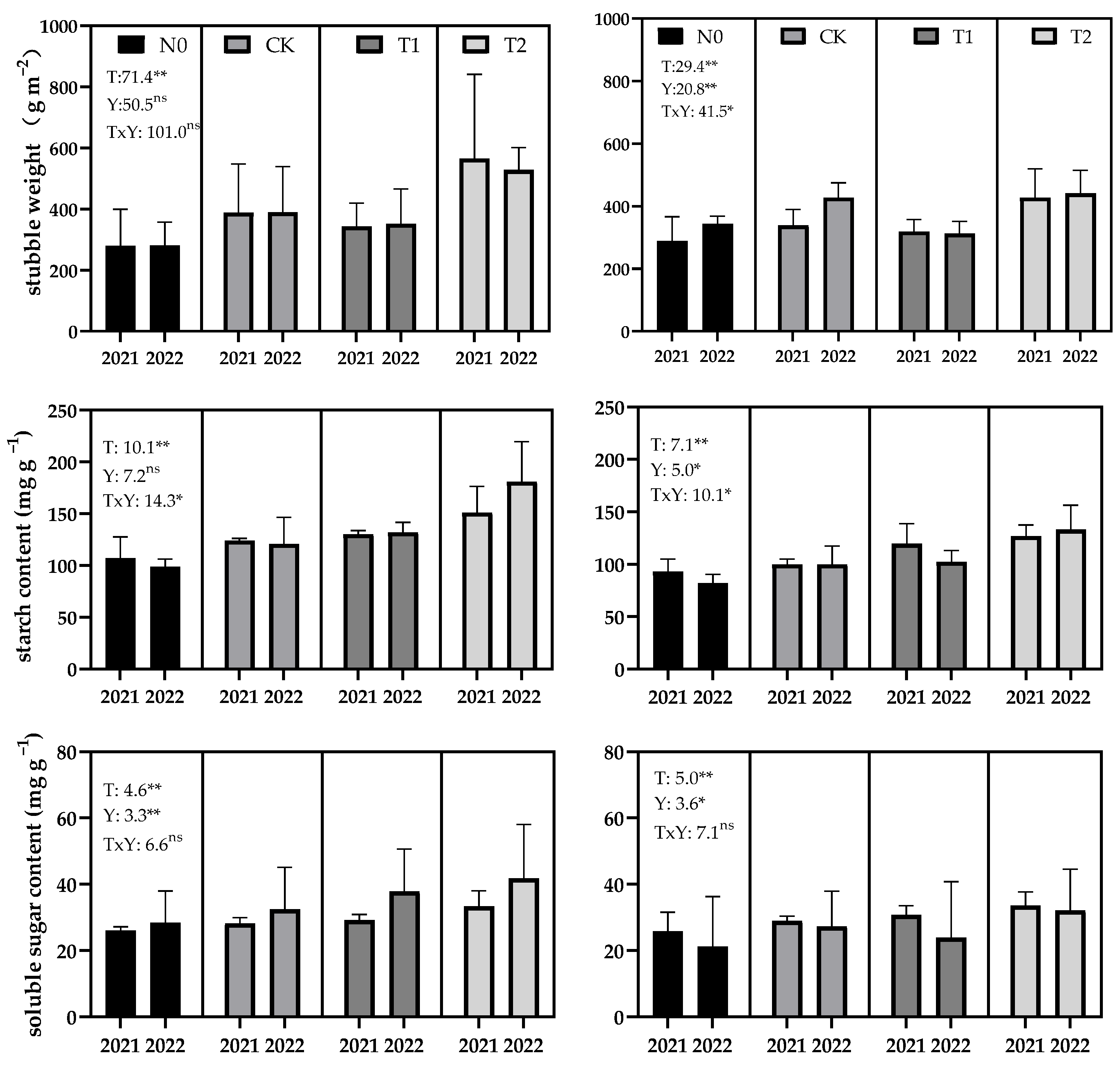Optimum Cultivation Model Increased the Grain Yield of Ratoon Rice and Nitrogen Agronomic Efficiency by Improving Root Morphological Traits and Stubble Character of the Main Rice
Abstract
:1. Introduction
2. Materials and Methods
2.1. Ratoon Rice Planting
2.2. Experimental Design and Field Management
2.3. Measurements and Methods
2.3.1. Measurement of Aboveground Total Dry Weight, and Yield and Its Components
2.3.2. Measurements of Nitrogen Agronomic Efficiency
2.3.3. Measurements of Root Morphology Traits
2.3.4. Measurements of Soluble Sugar, Starch Content in the Stubbles
- (1)
- Soluble sugar concentration (%) = [(C × V/a)/(W × 1000)] × In the formula: C—the mg value of glucose obtained from the standard curve; V—total volume of sample extract (mL); a—Amount of extraction solution taken during color development (mL); W—sample weight (g)
- (2)
- Starch concentration (%) = [(C × V/a) × 0.9/(W × 1000)] × In the formula: C—the mg value of glucose obtained from the standard curve; V—total volume of sample extract (mL); a—amount of extraction solution taken during color development (mL); W—sample weight (g); 0.9 is the conversion coefficient of glucose to starch.
2.4. Data Analysis
3. Results
3.1. Yield and Its Component of the Main Rice and Ratoon Rice
3.2. Nitrogen Agronomic Efficiency of the Ratoon Rice
3.3. Root Morphological Traits in the Flowering Stage
3.4. Stubble Weight of the Main Rice and Its Non-Structure Carbohydrate Contents
3.5. Ratoon Rice Yield and AEN Associated with Root and Stubble Parameters
4. Discussion
5. Conclusions
Author Contributions
Funding
Data Availability Statement
Acknowledgments
Conflicts of Interest
References
- Li, G.; Tang, J.; Zheng, J.; Chu, C. Exploration of rice yield potential: Decoding agronomic and physiological traits. Crop J. 2021, 9, 577–589. [Google Scholar] [CrossRef]
- Ren, D.; Li, Y.; He, G.; Qian, Q. Multifloret spikelet improves rice yield. New Phytol. 2020, 225, 2301–2306. [Google Scholar] [CrossRef] [Green Version]
- Dong, H.; Chen, Q.; Wang, W.; Peng, S.; Huang, J.; Cui, K.; Nie, L. The growth and yield of a wet-seeded rice-ratoon rice system in central China. Field Crops Res. 2017, 208, 55–59. [Google Scholar] [CrossRef]
- Yin, Y.; Peng, X.; Guo, S.; Zhai, L.; Hua, L.; Wang, H.; Liu, H. How to improve the light-simplified and cleaner production of rice in cold rice areas from the perspective of fertilization. J. Clean. Prod. 2022, 361, 131694. [Google Scholar] [CrossRef]
- Kuang, N.; Mo, W.W.; Tang, Q.Y.; Wang, W.Q.; Zheng, H.B. Comparative Analysis on Yield Formation between Ratoon Rice and Late Rice. Hybrid Rice 2021, 36, 48–53. [Google Scholar] [CrossRef]
- Yuan, S.; Cassman, K.G.; Huang, J.L. Can ratoon cropping improve resource use efficiencies and profitability of rice in central China? Field Crops Res. 2019, 234, 66–72. [Google Scholar] [CrossRef]
- Wang, F.; Huang, J.; Peng, S. Research and development of mechanized rice ratooning technology in China. China Rice 2021, 27, 1–6, (In Chinese with English Abstract). [Google Scholar]
- Yang, D.; Peng, S.; Zheng, C.; Xiang, H.; Huang, J.; Cui, K.; Wang, F. Effects of nitrogen fertilization for bud initiation and tiller growth on yield and quality of rice ratoon crop in central China. Field Crops Res. 2021, 272, 108286. [Google Scholar] [CrossRef]
- Zheng, C.; Wang, Y.; Yuan, S.; Xiao, S.; Sun, Y.; Huang, J.; Peng, S. Heavy soil drying during mid-to-late grain filling stage of the main crop to reduce yield loss of the ratoon crop in a mechanized rice ratooning system. Crop J. 2022, 10, 280–285. [Google Scholar] [CrossRef]
- Tang, Q.Y.; Qing, X.G. Technological advancement and production development counter-measures of ratooning rice in Hunan Province. Hybrid Rice 2023, 38, 1–9. [Google Scholar] [CrossRef]
- Liu, G.F.; Wang, X.D.; Wu, Y.J. Preliminary studies on the cultivation physiology of ratoon rice root. J. Anhui Agric. Sci. 1990, 2, 105–109. [Google Scholar] [CrossRef]
- Luo, Y. Dependence Relation of Aerial Part Traits and Root Traits of Rice in Heilongjiang Province. Chin. Agric. Sci. Bull. 2010, 26, 165–168, (In Chinese with English Abstract). [Google Scholar]
- Zheng, J.S. The Characteristics of High-Yielding Cultivation and Gene Mapping for Related Traits of Ratoon Rice (Oryza sativa L.). Ph.D. Thesis, Fujian Agricultural and Forestry University, Fuzhou, China, 2004. [Google Scholar]
- Zheng, J.S.; Lin, W.; Zhuo, C.Y.; Fang, X.J.; Lin, W.X. The correlation of dry biomass and activity of root system with grain yield in ratoon rice (Oryza sativa L.). Chin. J. Eco-Agric. 2004, 12, 106–109, (In Chinese with English Abstract). [Google Scholar]
- Zhou, W.X. Comparative Studies on Growth Characteristics and Source-Sink Relationship of Different Types of Ratooning Rice. Ph.D. Thesis, Hunan Agricultural University, Changsha, China, 2006. [Google Scholar]
- Chen, H.F.; Pang, X.M.; Zhang, R.; Zhang, Z.X.; Xu, Q.H.; Fang, C.X.; Li, J.Y.; Lin, W.X. Effects of Different irrigation and fertilizer application regimes on soil enzyme activities and microbial functional diversity in rhizosphere of ratooning rice. Acta Agron. Sin. 2021, 43, 1507–1517. [Google Scholar] [CrossRef]
- Xiong, H.; Ran, M.L.; Xu, F.X.; Hong, F. Achievements and Developments of Ratooning Rice in South of China. Acta Agrnomica Sin. 2000, 26, 297–304. [Google Scholar] [CrossRef]
- Xu, F.; Zhang, L.; Zhou, X.; Guo, X.; Jiang, P. The ratoon rice system with high yield and high efficiency in China: Progress, trend of theory and technology. Field Crops Res. 2021, 272, 108282. [Google Scholar] [CrossRef]
- He, A.B. Effect of Source-Sink Regulation at Main Season on the Regeneration Ability of Ratoon Rice and Its Mechanism. Ph.D. Thesis, Huazhong Agricultural University, Wuhan, China, 2022. [Google Scholar]
- Santos, A.B.; Fageria, N.K.; Prabhu, A.S. Rice ratooning management practices for higher yields. Commun. Soil Sci. Plant Anal. 2003, 34, 881–918. [Google Scholar] [CrossRef]
- Lal, B.; Gautam, P.; Nayak, A.K.; Raja, R.; Panda, B.B.; Tripathi, R.; Rathore, V.S. Agronomic manipulation in main season and ratoon rice influences growth, productivity, and regeneration ability in tropical lowlands. Field Crops Res. 2023, 294, 108872. [Google Scholar] [CrossRef]
- Xu, F.X.; Xiong, H. Relationship between ratio of grain to leaf area and ratooning ability in middle season hybrid rice. Chin. J. Rice Sci. 2000, 14, 249–252, (In Chinese with English Abstract). [Google Scholar]
- Qin, J.Q.; Impa, S.M.; Tang, Q.Y.; Yang, S.H.; Yang, J.; Tao, Y.S.; Jagadish, K.S.V. Integrated nutrient, water and other agronomic options to enhance rice grain yield and N use efficiency in double-season rice crop. Field Crops Res. 2013, 148, 15–23. [Google Scholar] [CrossRef]
- Yoshida, S.; Forno, D.A.; Cock, J.H.; Gomez, K.A. Laboratory Manual for Physiological Studies of Rice; International Rice Research Institute Press: Manila, Philippines, 1976; Volume 11, pp. 46–50. [Google Scholar]
- Huang, M.; Jiang, L.; Xia, B.; Zou, Y.; Jiang, P.; Ao, H. Yield gap analysis of super hybrid rice between two subtropical environments. Aust. J. Crop Sci. 2013, 7, 600–608. [Google Scholar]
- Sui, B.; Feng, X.M.; Tian, G.L.; Hu, X.Y.; Shen, Q.R.; Guo, S.W. Optimizing nitrogen supply increases rice yield and nitrogen use efficiency by regulating yield formation factors. Field Crops Res. 2013, 150, 99–107. [Google Scholar] [CrossRef]
- Huang, M.; Chen, J.N.; Cao, F.B.; Zou, Y.B. Increased hill density can compensate for yield loss from reduced nitrogen input in machine-transplanted double-cropped rice. Field Crops Res. 2018, 221, 333–338. [Google Scholar] [CrossRef]
- Zheng, H.B.; Li, B.; Wang, W.Q.; Lei, E.; Tang, Q.Y. Effects of different cultivation models on solar radiation-nitrogen use efficiency and yield of “Early Indica-Late Japonica” double rice. Sci. Agric. Sin. 2021, 54, 1565–1578. [Google Scholar] [CrossRef]
- Kamiji, Y.; Yoshida, H.; Palta, J.A.; Sakuratani, T.; Shiraiwa, T. N applications that increase plant N during panicle development are highly effective in increasing spikelet number in rice. Field Crops Res. 2011, 122, 242–247. [Google Scholar] [CrossRef]
- Zhao, F.; Xu, C.M.; Zhang, W.J.; Zhang, X.F.; Cheng, J.P.; Wang, D.Y. Effects of rhizosphere dissolved oxygen and nitrogen form on root characteristics and nitrogen accumulation of rice. Chin. J. Rice Sci. 2011, 25, 195–200. [Google Scholar] [CrossRef]
- Zhang, X.F.; Wang, D.Y.; Qu, Y.Y.; Li, H. Morphological and physiological characteristics of raised bed-cultivated rice. Acta Agron. Sin. 2005, 31, 742–748. [Google Scholar] [CrossRef]
- Qian, Y.D.; Li, J.F.; Zheng, G.P.; Lu, Y.D.; Guo, X.H.; Sun, C.Y. Effect of ridge cultivation on root growth of rice in cold region. Chin. J. Rice Sci. 2005, 19, 238–242. [Google Scholar] [CrossRef]
- Quan, M.H.; Hu, A.S.; Ou, L.J.; Hu, D.Y.; Li, B.H. Effects of Tillage Mode on Characteristics of Photosynthesis and Root Growth of Rice. Hybrid Rice 2012, 27, 71–75. [Google Scholar] [CrossRef]






| Cultivation Model | Nitrogen Application | Planting Density | Other Measures |
|---|---|---|---|
| No-fertilizer model (N0) | 0 kg N ha−1 | 25 hills m−2 2–3 seedling hills−1 | 45 kg P ha−1, 90 kg K ha−1 |
| Farmer’s practice model (CK) | 150 kg N ha−1 (7:3:0) | 25 hills m−2 2–3 seedling hills−1 | 30 kg P ha−1, 60 kg K ha−1 |
| High-yield and high-efficiency model (T1) | 120 kg N ha−1 (5:3:2) | 30 hills m−2 4–5 seedling hills−1 | 45 kg P ha−1, 90 kg K ha−1, Zinc sulfate 5 kg ha−1 |
| Enhanced-high-yield and high-efficiency model (T2) | 150 kg N ha−1 (4:3:3) | 32 hills m−2 5–6 seedling hills−1 | Ridge tillage, organic fertilizer 1.8 t ha−1, 50 kg P ha−1, 100 kg K ha−1 (5:5), Zinc sulfate 5 kg ha−1 |
Disclaimer/Publisher’s Note: The statements, opinions and data contained in all publications are solely those of the individual author(s) and contributor(s) and not of MDPI and/or the editor(s). MDPI and/or the editor(s) disclaim responsibility for any injury to people or property resulting from any ideas, methods, instructions or products referred to in the content. |
© 2023 by the authors. Licensee MDPI, Basel, Switzerland. This article is an open access article distributed under the terms and conditions of the Creative Commons Attribution (CC BY) license (https://creativecommons.org/licenses/by/4.0/).
Share and Cite
Zheng, H.; Liu, S.; Zou, D.; He, Z.; Chen, Y.; Gai, P.; Wang, W.; Tang, Q. Optimum Cultivation Model Increased the Grain Yield of Ratoon Rice and Nitrogen Agronomic Efficiency by Improving Root Morphological Traits and Stubble Character of the Main Rice. Agronomy 2023, 13, 1707. https://doi.org/10.3390/agronomy13071707
Zheng H, Liu S, Zou D, He Z, Chen Y, Gai P, Wang W, Tang Q. Optimum Cultivation Model Increased the Grain Yield of Ratoon Rice and Nitrogen Agronomic Efficiency by Improving Root Morphological Traits and Stubble Character of the Main Rice. Agronomy. 2023; 13(7):1707. https://doi.org/10.3390/agronomy13071707
Chicago/Turabian StyleZheng, Huabin, Shanzhen Liu, Dan Zou, Zaizhou He, Yuanwei Chen, Panpan Gai, Weiqin Wang, and Qiyuan Tang. 2023. "Optimum Cultivation Model Increased the Grain Yield of Ratoon Rice and Nitrogen Agronomic Efficiency by Improving Root Morphological Traits and Stubble Character of the Main Rice" Agronomy 13, no. 7: 1707. https://doi.org/10.3390/agronomy13071707





